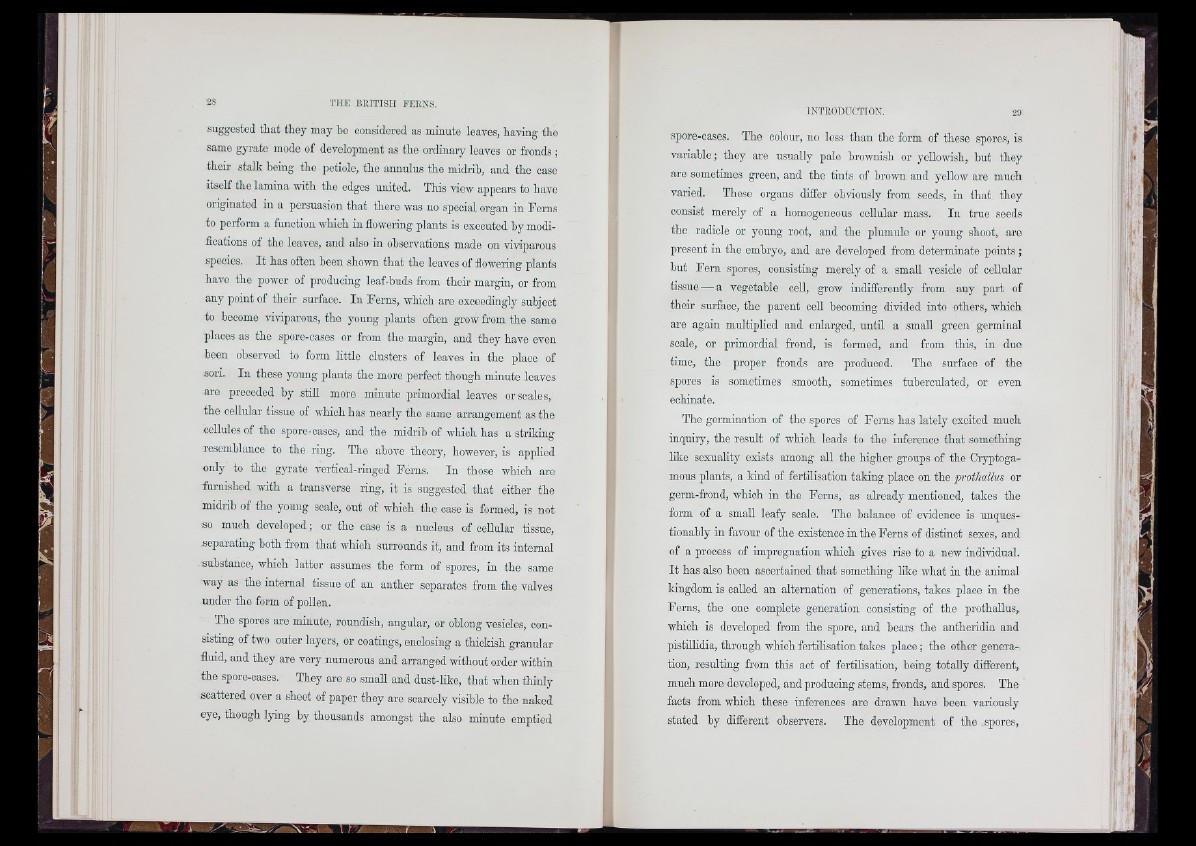
suggested that they may bo considered as minute leaves, having the
same gyrate mode of development as the ordinary leaves or fronds ;
their stalk being tho petiole, the annulus the midrib, and the case
itself the lamina with the edges united. This view appears to have
originated in a persuasion that there was no special organ in Forns
to perform a function which in flowering plants is executed by modifications
of tho leaves, and also in observations made on viviparous
species. I t has often been shown that the leaves of flowering plants
have the power of producing leaf-buds from their margin, or from
any point of thoir surface. In Ferns, which are exceedingly subject
to become viviparous, tho young plants often grow from the same
places as the sporo-cases or from the margin, and they have even
been observed to form little clusters of leaves in the place of
sori. In these young jjlants the more perfect though minute leaves
are preceded hy stiU more minute primordial leaves or scales,
the cellular tissue of which has nearly the same arrangement as the
cellules of the spore-oases, and tho midrib of which has a striking
resemblance to the ring. The above theory, however, is applied
only to the gyrate vertical-ringed Ferns. In those which aro
furnished rvith a transverse ring, it is suggested that either the
midrib of the young scale, out of which the case is formed, is not
so much developed; or the case is a nucleus of ceUular tissue,
separating both from that which surrounds it, and from its internal
substance, which latter assumes the form of spores, in the same
way as the internal tissue of an anther separates from the valves
under the form of pollen.
The spores are minute, roundish, angular, or oblong vesicles, consisting
of two outer layers, or coatings, enclosing a thickish granular
fluid, and they are very numerous and arranged without order within
tho spore-cases. They are so small and dust-hke, that when thinly
scattered over a sheet of paper they are scarcely visible to the naked
eye, though lying by thousands amongst the also minute emptied
spore-oases. The colour, no less than the form of these spores, is
variable; they are usually pale brownish or yellowish, but they
are sometimes green, and the tints of brown and yellow are much
varied. These organs differ obviously from seeds, in that they
consist merely of a homogeneous cellular mass. In true seeds
the radicle or young root, and the plumule or young shoot, are
present in the embryo, and aro developed from determinate points ;
hut Fern spores, consisting merely of a small vesiclo of ceUular
tissue — a vegetable coll, grow indifferently from any part of
their surface, the parent cell becoming divided into others, which
are again multiplied and enlarged, until a small green germinal
scale, or primordial frond, is formod, and from this, in due
time, the proper fronds are produced. The surface of the
spores is sometimes smooth, sometimes tuhcroulatcd, or oven
Gchinato.
The germination of the spores of Forns has lately excited much
inquiry, the result of which leads to the inference th a t something
like sexuality exists among all the higher groups of the Cryptoga-
mous plants, a kind of fertilisation taking place on the prothallus or
germ-frond, which in the Ferns, as already mentioned, takes the
form of a smaU leafy scale. The balance of evidence is unquestionably
in favour of the existence in the Ferns of distinct sexes, and
of a process of impregnation which gives rise to a new individual.
I t has also been ascertained th a t something Uke what in the animal
kingdom is called an alternation of generations, takes place in the
Ferns, the one complete generation consisting of tho prothallus,
which is developed from the spore, and bears the antheridia and
pistillidia, thi’ough which fertilisation takes place; the other generation,
resulting from this act of fertilisation, being totaUy different,
much more developed, and producing stems, fronds, and spores. The
facts from which these inferences are drawn have been variously
stated hy different observers. The development of the spores,
ill-I
Ifi.;
ii
, ;'l